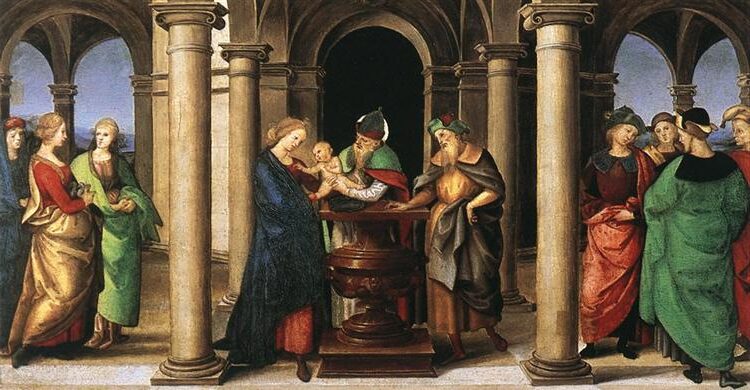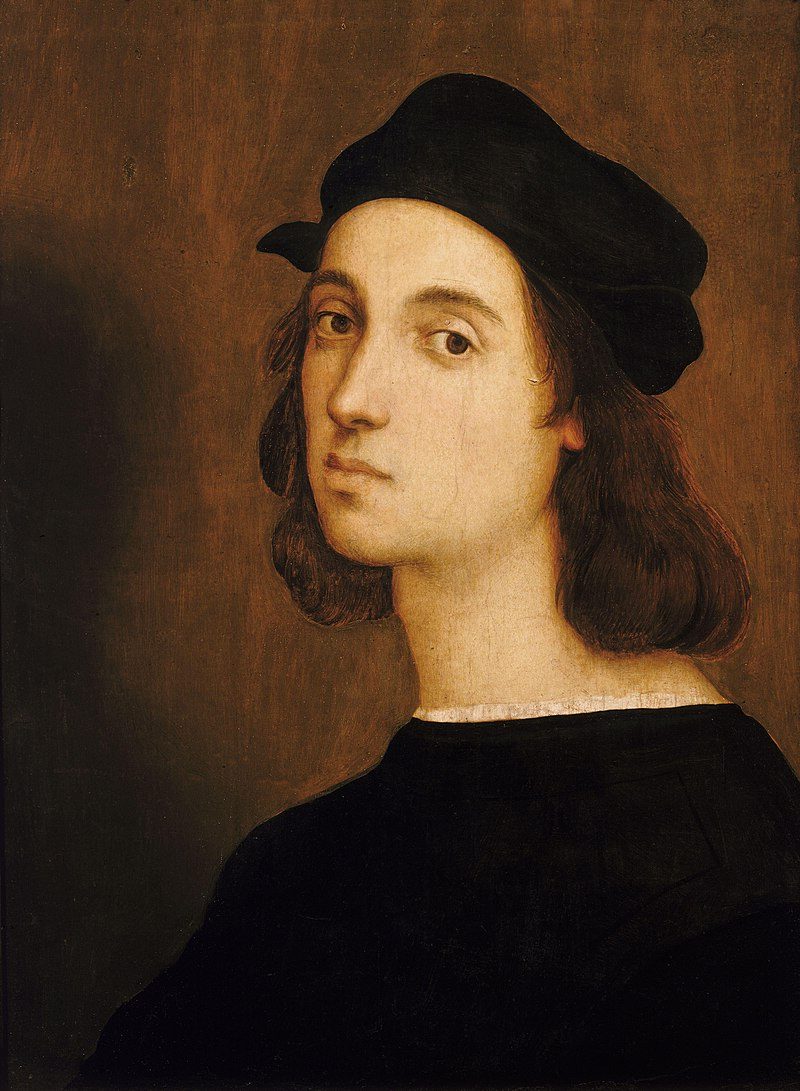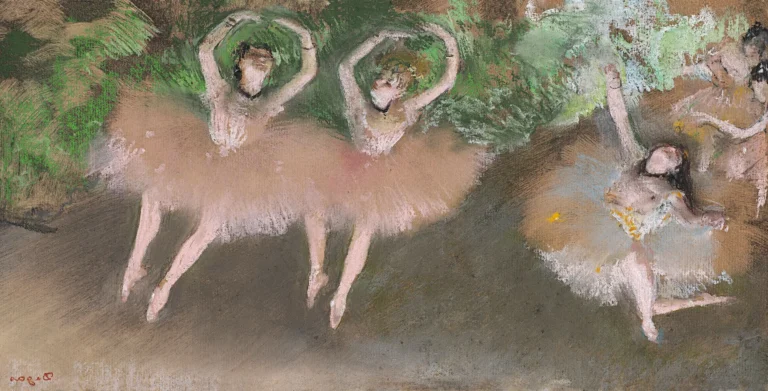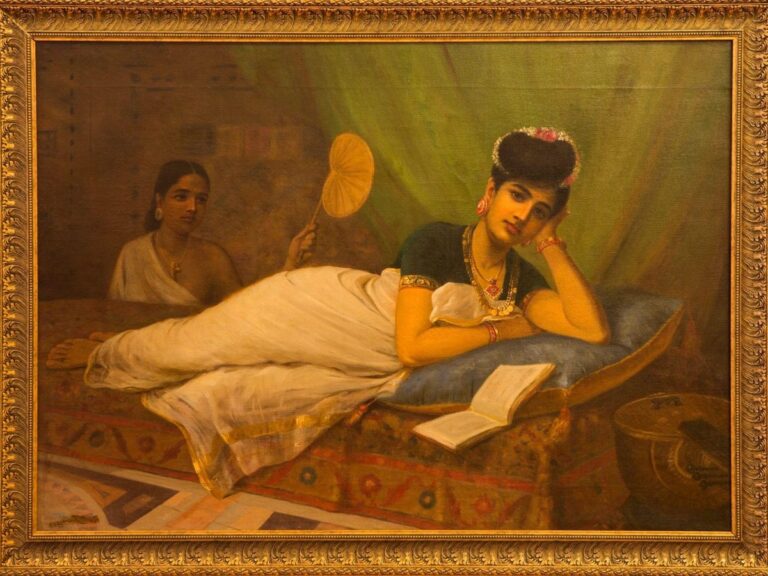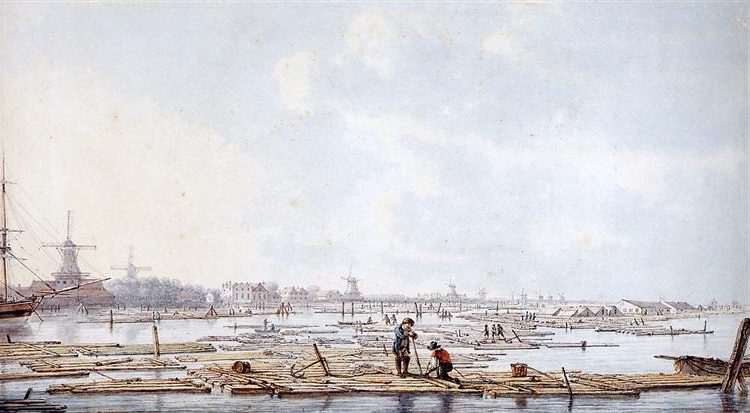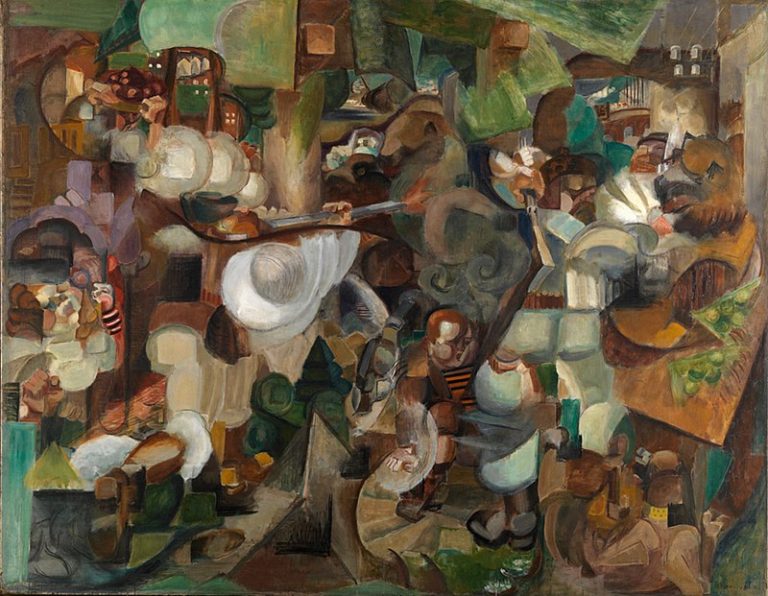Raphael Sanzio Painter: The Renaissance Master Who Transformed Italian Art
Born: March 28 or April 6, 1483, Urbino, Duchy of Urbino
Death: April 6, 1520, Rome, Papal States
Art Movement: High Renaissance
Nationality: Italian
Teacher: Pietro Perugino
Raphael Sanzio Painter: The Renaissance Master Who Transformed Italian Art
Early Life and Training
Raphael Sanzio’s artistic journey began in the culturally rich environment of Renaissance Italy. His early exposure to art through his father and later training with a master painter laid the groundwork for his remarkable career.
Birth in Urbino and Artistic Lineage
Raphael was born on April 6 (or possibly March 28), 1483, in Urbino, Italy. This city was an important cultural center that actively encouraged the arts during the Renaissance period.
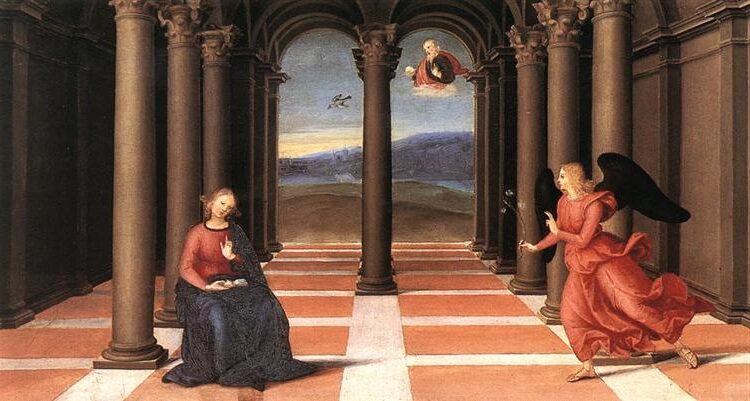
The Annunciation by Raphael Sanzio, 1502 – 1503
His father, Giovanni Santi, was a respected court painter who worked for the Duke of Urbino. This artistic heritage gave young Raphael early exposure to painting techniques and the world of art.
Giovanni provided Raphael with his first painting instructions, introducing him to the fundamentals of the craft. Sadly, Raphael’s father died in 1494 when the boy was only 11 years old, marking a significant turning point in his young life.
Apprenticeship with Perugino
Following his father’s death, Raphael likely began his formal training in the workshop of Pietro Perugino, one of the most renowned painters in central Italy at the time. Perugino’s studio was located in Perugia.
Under Perugino’s guidance, Raphael learned the technical aspects of painting and developed his artistic style. He was particularly influenced by Perugino’s clarity of composition and serene figures.
By 1500, when Raphael was approximately 17 years old, he was already described as a fully trained “master” painter. This title demonstrated his exceptional talent and rapid development as an artist.
During this apprenticeship period, Raphael absorbed various techniques and approaches that would later form his distinctive style, while beginning to establish his reputation in the artistic communities of northern Italy.
Major Works and Artistic Contributions
Raphael’s remarkable talent produced iconic works that defined High Renaissance ideals of harmony, beauty, and compositional balance. His versatility shines through his frescoes, portraits, religious paintings, and architectural designs.
Iconic Frescoes and the Stanza della Segnatura
Raphael’s most celebrated achievements are the frescoes he created for Pope Julius II in the Vatican Palace. The Stanza della Segnatura, completed between 1508-1511, houses his masterpiece “The School of Athens,” which brilliantly depicts ancient philosophers in a harmonious architectural setting. Plato and Aristotle stand at its center, representing different philosophical approaches.
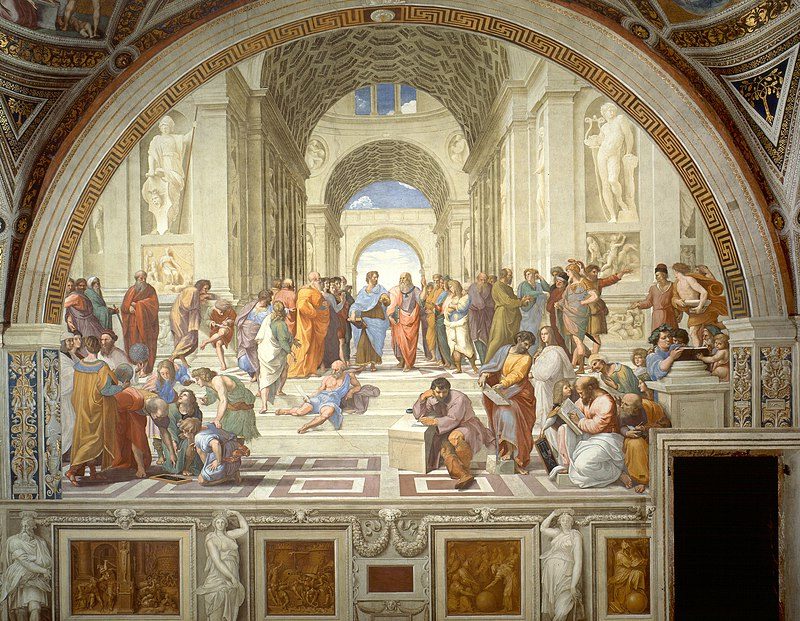
The School of Athens, 1509–1511 by Raphael Sanzio
In this same room, Raphael painted “Disputation of the Sacrament” and “Parnassus,” works that symbolize theology and poetry respectively. These frescoes demonstrate his ability to organize complex scenes with numerous figures.
He continued his Vatican commissions in additional rooms (Stanze), creating “The Mass at Bolsena” and “The Expulsion of Heliodorus,” which show his evolving style and mastery of dramatic narrative.
Portraits and Madonnas: A Display of Humanism
Raphael’s portraits reveal his deep understanding of human psychology and character. His subjects appear natural yet idealized, showing his remarkable ability to capture individuality.


His many Madonna paintings, created throughout his career, display his evolving style. Early works like “Madonna del Granduca” show Florentine influences, while later pieces like “Sistine Madonna” reveal greater complexity and emotional depth.
These religious paintings balance divine beauty with human tenderness. The Madonna figures appear both heavenly and approachable – a perfect blend of spiritual and humanist ideals that defined Renaissance thinking.
Raphael’s skill in portraying human emotion and beauty made his works extremely popular and widely imitated.
Late Works and Architectural Achievements
In his final years, Raphael expanded his artistic range considerably. “The Transfiguration,” his last major painting left unfinished at his death in 1520, shows his movement toward more dramatic compositions that influenced later Mannerist artists.

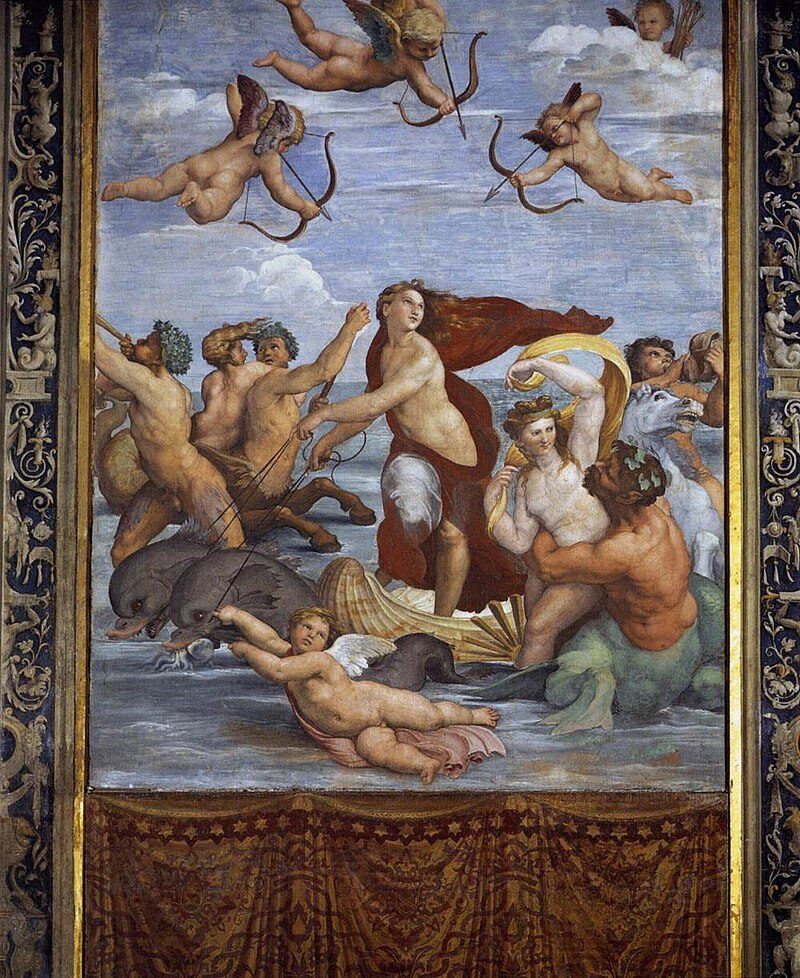
He decorated the Villa Farnesina with scenes including “The Triumph of Galatea,” showcasing his mastery of mythological subjects. Raphael also designed cartoons for tapestries depicting scenes from the lives of Saints Peter and Paul for the Sistine Chapel.
As architect, Raphael took charge of St. Peter’s Basilica construction after Bramante’s death. He designed the Chigi Chapel in Santa Maria del Popolo and several Roman palaces, applying the same principles of harmony and proportion found in his paintings.
His versatility in multiple artistic fields cemented his reputation as one of the most complete Renaissance artists.
Influences and Legacy
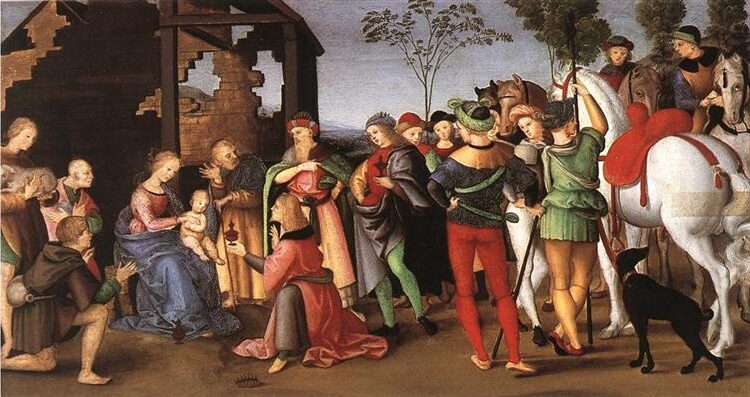
The Adoration of the Magi by Raphael Sanzio, 1502 – 1503
Raphael’s artistic genius not only defined the High Renaissance but continues to impact art today. His work represents a unique synthesis of influences, technical mastery, and innovative approaches that made him one of the Great Masters.
Contemporaries: Michelangelo and Leonardo
Raphael absorbed valuable lessons from his accomplished contemporaries. In Florence, he studied Leonardo da Vinci’s compositions and sfumato technique, adopting the soft transitions between colors. From Michelangelo, he learned about powerful figural arrangements and anatomical precision.
Unlike the older masters, Raphael developed a distinctive style that blended their strengths. While Michelangelo was known for intensity and Leonardo for mystery, Raphael achieved harmony and clarity.
Pope Leo X favored Raphael over Michelangelo, appointing him chief architect of St. Peter’s Basilica after Bramante’s death. This rivalry pushed Raphael to continually evolve his approach.
His collaborative workshop method differed from his contemporaries’ more solitary practices. Raphael trained numerous assistants who spread his techniques throughout Italy.
Impact on Renaissance Art and Beyond
Raphael’s influence extended far beyond his short lifetime. His paintings established new standards for composition, color harmony, and emotional expressiveness in Renaissance art.
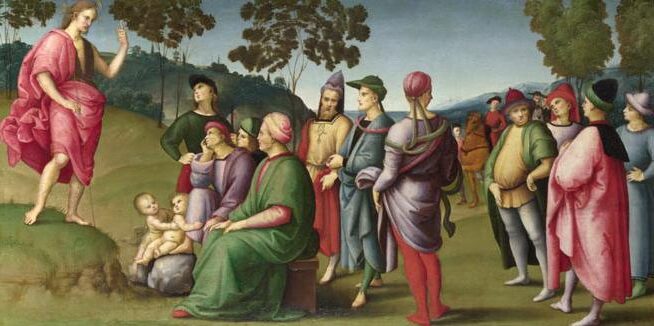
Saint John the Baptist Preaching by Raphael Sanzio, 1505
Giorgio Vasari, the first art historian, praised Raphael as the most complete artist of the High Renaissance. This assessment helped cement Raphael’s reputation for generations.
His works in the Vatican, especially the School of Athens and Stanze, became essential study material for artists. The “Raphael Rooms” still attract thousands of visitors annually.
Major museums like the National Gallery in London feature his paintings prominently. His Madonnas became the model for religious art, combining human tenderness with divine dignity.
The clarity and balance in Raphael’s compositions influenced academic painting traditions across Europe for centuries after his death.
Frequently Asked Questions
Raphael Sanzio stands as one of the Renaissance’s most influential artists, known for his technical mastery and profound impact on Western art. His life, though relatively short, was marked by remarkable achievements and notable works that continue to captivate art enthusiasts worldwide.
What is considered Raphael’s most notable contribution to the Renaissance?
Raphael’s greatest contribution to the Renaissance was his perfect synthesis of classical harmony, ordered beauty, and serene humanism. His compositions achieved a balance and clarity that defined High Renaissance ideals.
He brought a new level of emotional depth and psychological insight to religious subjects while maintaining technical perfection. This approach influenced generations of artists who followed him.
Raphael’s fresco techniques, particularly in the Vatican Stanze (Rooms), demonstrated his mastery of space, perspective, and human form. These works served as textbook examples of Renaissance principles.
Which three masterpieces are Raphael best known for?
“The School of Athens” stands as Raphael’s most celebrated fresco, painted in the Vatican’s Stanza della Segnatura. It depicts great philosophers and scientists gathered in an architectural setting, perfectly capturing Renaissance humanism.
“The Sistine Madonna” features the Virgin Mary holding baby Jesus while standing on clouds between Saints Sixtus and Barbara. The cherubs at the bottom have become iconic images in their own right.
“The Transfiguration” was Raphael’s final painting, showing Christ’s divine revelation above while his disciples attempt to heal a boy below. This powerful work bridges earthly struggles and divine glory.
What events marked the early life of Raphael, particularly by the age of 11?
By age 11, Raphael had already experienced significant personal tragedy with the death of his mother in 1491 when he was only 8 years old. His father, Giovanni Santi, died just three years later.
Despite these losses, Raphael received early artistic training in his father’s workshop. Giovanni Santi was a respected court painter to the Duke of Urbino, providing Raphael access to artistic education from birth.
These early experiences forced Raphael to mature quickly. He began working as an assistant in prestigious workshops in Urbino, showing remarkable talent well before his teenage years.
Can you list ten significant facts about Raphael’s life and career?
- Raphael was born in Urbino, Italy in 1483, a cultural center known for its artistic environment.
- He completed his first commissioned work at age 17, showing his early professional development.
- Raphael never married but was engaged to Maria Bibbiena, the niece of Cardinal Medici.
- He managed a large workshop with 50 pupils and assistants, unusual for an artist of his time.
- Raphael was appointed architect of St. Peter’s Basilica in 1514, following Bramante’s death.
- He was known for his ability to absorb influences from other masters while developing his own style.
- Raphael documented and drew Roman ruins, showing his interest in classical architecture.
- He was nicknamed “Il Divino” (The Divine One) by his contemporaries for his exceptional talents.
- Raphael produced over 100 Madonnas and Holy Family paintings throughout his career.
- He was made a “Groom of the Chamber” at the papal court, a prestigious position reflecting his status.
What circumstances led to Raphael’s death?
Raphael died unexpectedly on April 6, 1520, at the young age of 37. His death occurred on his birthday, adding a poignant note to his untimely passing.
Historical accounts suggest he contracted a severe fever after excessive work and possibly some romantic encounters. Some historians believe he may have been weakened by overwork on his extensive Vatican commissions.
The medical treatment he received, including bloodletting, likely worsened his condition rather than helping it. His funeral was a major public event, and he was buried in the Pantheon in Rome, an honor reflecting his immense status.
How extensive was Raphael’s influence in shaping the course of Western art?
Raphael’s balanced compositions became a foundation for academic art training for centuries. His works were used as teaching models in art academies across Europe until the 19th century.
His approach to depicting human figures was also influential. Countless artists were inspired by his idealizing yet naturalistic style.
His clear organization of complex scenes became a standard for historical and religious painting. Additionally, his workshop practices established a production model that many later artists adopted.
Raphael’s prints circulated widely, spreading his influence throughout Europe. Artists from Rubens to Ingres explicitly referenced and borrowed from Raphael’s compositions.
Even when artistic movements rejected classical ideals, they defined themselves in opposition to the tradition Raphael helped establish.

